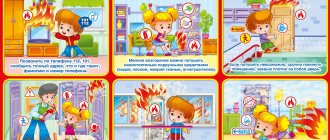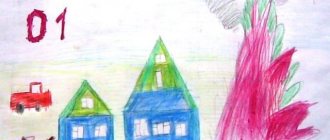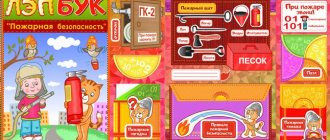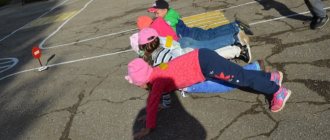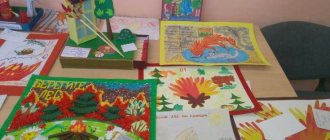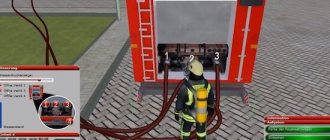Rules for children's behavior in case of fire
Teachers prepare a lesson on fire safety in the senior group in advance, thinking through materials and notes on behavior during a dangerous situation. According to the Federal State Educational Standard, during the conversation they must give answers to questions about handling matches, electronics, lighters, as well as an action plan during a fire both in kindergarten and at school.
How to behave during a fire
During the conversation, the guys will learn the sequence of actions in case of an emergency:
- If a fire occurs, immediately call 01 and give your address and last name. At this stage, many people often get lost, especially children. This comes from fear. The main thing in such a situation is to teach children self-control.
- Call adults: parents, neighbors. Even if the fire occurred due to the child’s fault, he must understand that he should not remain silent about it.
- Under no circumstances should you hide or let other children do this. Rescuers may not find them.
- If possible, run out of the building through the front door.
- If there is a balcony, and other paths are cut off by smoke or fire, you cannot jump from it. You need to go out into the air and close the doors, from there you need to loudly call for help.
- Another option is a window. Before opening it, close all the doors and plug the cracks (with rags, clothes, etc.), then lie down on the floor, closing the airways with a damp cloth.
Such rules are universal everywhere - at home, in kindergartens, at school.
Conversation “Rules of conduct in case of fire”
2. Immediately leave the premises, checking to see if there are anyone left in the apartment who cannot get out on their own (the sick, the elderly, children);
3. If there are no adults, call the fire department by phone 01 (112), tell the exact address, what is burning and where, your name and phone number.
The basic rule for extinguishing a fire is the following: cover the burning object with a thick cloth or blanket and immediately leave the room, tightly closing the door behind you.
Particular attention should be paid to what not to do in case of fire:
*extinguish the fire until the fire department is called (during this time a large fire may break out);
*extinguish electrical appliances with water, as water conducts electricity well;
*try to exit through a smoke-filled stairwell (hot air burns the lungs, and smoke is very toxic);
* use the elevator;
* descend from the upper floors through drainpipes and risers using ropes and sheets, unless there is an urgent need for this, because in the absence of skills, a fall is almost always inevitable;
* open doors, windows and jump out of them.
If a fire occurs, you need to be prepared for anything, because the successful evacuation of the building, your life will depend on your correct actions.
Let's look at different situations that can happen:
Actions when evacuating from a burning or smoke-filled room:
1.Protect your eyes and respiratory organs.
2. Cover yourself with a thick damp cloth and move, crawling or crouching.
3. Take a flashlight with you, as it’s hard to see in a smoky room.
4. Do not enter areas where there is a high concentration of smoke.
If you cannot go outside due to thick smoke and high temperature, you should immediately return back, closing the door tightly behind you.
If the smoke concentration increases, then move around the room by crawling or crouching.
In multi-storey buildings, go towards the smoke-free staircase and then towards the exit. Hold on to the walls, handrails, breathe through a damp handkerchief. Using the elevator during a fire is strictly prohibited.
Actions if it is not possible to leave the apartment during a fire in the house:
1.Call the fire department, give your address and say that the exit to the stairs is closed.
2.Close the door to the apartment, plug all the cracks and ventilation holes with rags.
3.Create a supply of water in the bathroom.
4. Lock yourself in the room farthest from the entrance.
5. Get ready to signal to rescuers with a piece of bright fabric from the balcony.
6.If the smoke concentration is high or the temperature has risen sharply, go out onto the balcony, closing the door tightly behind you. Bring a soaked blanket or other thick cloth with you to protect yourself from fire if it comes through a window or door.
"Don't play with fire"
Using examples of active and educational games, you can show preschoolers that games with matches, lighters and open fire are very dangerous. One of these could be the game “Cross it out - it’s dangerous!” Its essence is that cards with objects are written or attached on the board. Children need to cross out those that, if handled carelessly, can cause a fire.
For your information! Another active game on the theme “don’t play with fire” is “Dragon”. One “dragon” is selected, and the rest of the children dance around it and say: “We won’t have fires, the dragon won’t scare us.” When a sleeping dragon wakes up, it waves red ribbons (flames). Those who are touched by the ribbon leave the circle.
My child is behaving badly, what should I do?
Fire safety rules for children
Every year, children under fourteen years of age are killed or seriously injured in fires and fires. The main reason can be called the dishonesty of parents, as well as the lack of knowledge and skills to behave in case of fire. To prevent fire safety, it is necessary to conduct lessons, conversations, and lectures.
It is recommended to consolidate the result with the help of games that help update the information received. Cartoons developed with the support of the Fire Service will help explain fire safety rules to young children (“Fire in the forest”, “Fire in the apartment”, “Rules of behavior for children in case of fire”).
Fire safety rules will be explained during life safety lessons, as well as during class hours on this topic. The use of poems by S. Marshak “Very, very important rules!”, “Song of Matches”, A. Usachev “Fire”, E. Gladkova “If there is a fire in the house” and others will help in this.
Basic fire safety rules for children
- You cannot play with matches, lighters, or match-candles;
- You cannot set fire to dry leaves, dry grass, trees, or poplar fluff;
- You cannot play with fireworks, sparklers, or firecrackers without adult supervision;
- You cannot use gasoline, kerosene and other flammable materials for gaming purposes;
- Do not throw bottles of deodorants, perfumes, air fresheners, etc. into a fire or set fire to them. This may result in an explosion and immediate fire;
- You cannot make a fire or play with an open fire indoors;
- You cannot make a fire in wooden sheds, dilapidated buildings, basements and attics;
- if there is a need for light, it is better to use a flashlight than matches;
About the fire - clearly
Bright pictures depicting burning appliances, furniture and toys will be a suitable visual aid for preschool children. They play games with them and ask riddles that will help the kids consolidate the material. The child guesses where a dangerous object (or a dangerous situation) is depicted and where it is not.
Cutting pictures
A didactic game where a whole drawing is assembled from cut pieces will appeal to younger children. Additionally, you can prepare coloring books, dotted drawings, or let the children themselves try to draw a picture on the topic of the lesson.
For open lessons in preparatory groups and primary classes, booklets are made where the topic is revealed in more seriousness and detail.
Fire safety conversation
During the conversation, you can use various works on the topic.
Short poems for children
The famous lines of K. Chukovsky “Confusion” well describe the danger of fire using the example of fairy-tale characters:
The sea is burning with flames. A whale ran out of the sea. -Hey, firefighters, run! Help! Help!
Example of a short poem
The teacher can also come up with small and easy to remember rhymes. Rhyming lines from children's poems can remain in memory even when the child grows up.
Be careful with fire. It is very important day after day. Once you give it free rein, it will immediately destroy our house. Destroying the grass, destroying the forest, He crawled into all the cracks. There is no one faster than the beast - the terrible one will leave his mark. So as not to anger the fire, we need to keep an eye on it.
Tales about fire safety
One of the popular fairy tales for fire safety classes in kindergarten is the familiar “Cat’s House” to many. They also stage skits or perform puppet shows based on it.
Important! A kindergarten employee can independently choose and read several short fairy tales, the life lesson of which is the danger of playing with fire.
Game “Call the Ministry of Emergency Situations”
Information is more easily absorbed by young children through play. The teacher can offer to act out a short scene where the scene will be the house where the fire started. The main thing is not to forget to remind children that a game is a game, and in life they need to act clearly and quickly, resorting to the rules that they have previously learned.
Call rescuers at number 01
During the game, children need to be taught composure. When a fire occurs, they often panic and rush to hide in a safer place - in a closet, under a bed, etc. During the game, preschoolers learn to act and get out of a dangerous place together.
Rules of behavior in the forest for children
You can consolidate your knowledge with each of the children: in turn, they will have to depict or tell what to do if a fire starts in their house. The rest of the children learn from the example of others, and together with the teacher they sort out mistakes.
Note! Through play, the child learns the importance of remaining calm and disciplined.
It is also important to make it clear that in emergency situations the emergency phone number does not immediately come to mind, so you should keep a list of emergency numbers nearby. This could be notes on your phone, a piece of paper in a notebook, a bookmark in a book, etc.
To better perceive information, the game uses special props (toy phones, painted fire) or even an entire scene in the form of a room in which it looks like a fire has started.
Instructions for fire safety in preschool educational institutions
Basic instructions on fire safety measures in preschool educational institutions, fire safety instructions for administration, employees, procedures for action in case of fire, etc. are presented.
The head of the kindergarten is responsible for fire safety and fire protection in the preschool educational institution. He may, by order, appoint a person responsible for fire safety in the institution. It is mandatory that those in charge must develop instructions on fire safety measures in preschool educational institutions (kindergarten), as well as in warehouses, in the catering department, in the sports and music halls. download: Documentation on Fire Safety in Preschool Educational Institutions 38 documents taking into account laws as of September 8, 2021!
- Instructions on fire safety measures in preschool educational institutions
- Instructions on fire safety measures in the catering department of preschool educational institutions
- Instructions on fire safety measures in a food warehouse in a preschool educational institution
- Instructions on fire safety measures in the warehouse of inventory and goods and materials in preschool educational institutions
- Instructions on fire safety measures in the laundry room of a preschool educational institution
- Job description for fire safety of the head of a preschool educational institution
- Job description of the person responsible for fire safety
- Fire safety instructions for the duty administrator of a preschool educational institution
download: Regulations for preschool educational institutions 84 regulations in a package or individually. Update date: 10/06/2021
It is very important to bring to the knowledge of all kindergarten employees the provisions of the instructions on the procedure for maintaining and bringing the premises of the preschool educational institution to a fire-safe condition in order to prevent fires in classrooms and flooding.
Fire safety: reminder
The teacher’s goal is to explain all the rules of conduct in case of fire for children, a reminder about which must also be present. Posters with booklets and bright pictures should be hung in the preschool educational institution itself so that children can come up and study them at any time. These notes contain:
- rules for handling electrical appliances;
- algorithm for extinguishing small fires;
- instructions for using a fire extinguisher;
- information about available fire extinguishing methods.
Small cards - fire safety reminders for children
Fire safety instructions in kindergarten
Officials and employees of a preschool educational institution must clearly know the procedure for action in the event of a fire and evacuation in order to evacuate children in a timely and safe manner, notify the fire service and the head of the preschool educational institution in a timely manner, and take appropriate measures to extinguish the source of fire in the absence of a threat to life.
download: Job descriptions for preschool educational institutions (Profstandard) 31 instructions individually and in packages, updated - September 5, 2021!
- Fire safety instructions for preschool employees
- Instructions on the procedure for officials to act in the event of a fire in a preschool educational institution
- Instructions on the actions of personnel during evacuation in case of fire in a preschool educational institution
- Instructions on the procedure for maintaining and bringing premises of preschool educational institutions to a fire-safe condition
- Instructions for fire safety during mass events
- Fire safety instructions for New Year's events
- Fire safety rules for children in preschool educational institutions
- Fire safety rules for children at home
- Procedure for employees to evacuate in the event of a fire at a preschool educational institution
- Instructions on fire safety measures during repair work of preschool educational institutions
- Instructions on fire safety measures when carrying out painting work at preschool educational institutions
- Instructions for fire safety when carrying out hot work at preschool educational institutions
Spring and summer fire danger
During the warm period, the risk of fires increases significantly. Both the older and younger groups need to be told that in spring and summer, special attention should be paid to bonfires and other open fire, since any carelessness can cause a nearby thing or person to ignite. You cannot play with matches in the garden, or set fire to grass and branches for fun while walking.
Important! During the winter period, the main emphasis is on safety in the building, as well as during the New Year holidays.
Lesson on the topic “Fire safety for children at school and at home”
Educator: Dityuk E.P.
Goal: to teach children to observe fire safety rules, evaluate actions and draw conclusions.
Equipment: computer, multimedia, interactive whiteboard, presentation, video, story pictures with dangerous fire situations.
Progress of the lesson
I. A story about the causes of fires.
Teacher. Fire plays an exceptional role in human life. Heating our homes, cooking, the development of science and technology - everything is connected with fire. It took humanity many years to learn how to make and use fire. But, just like water, which is necessary for human life, brings enormous disasters during periods of heavy floods, so fire, which creates enormous benefits with the help of people, if treated carelessly can turn into a ruthless enemy, destroying cities and villages, factories and factories, taking away human lives.
All of you guys have seen red cars with alarm sirens rushing through the city. Fire! Why does it happen?
Most fires occur due to the fault of people themselves, due to their carelessness, and approximately every sixth fire in the residential sector occurs due to the fault of children and adolescents. You are listening now and thinking that this does not apply to you personally, you personally do not play with matches. And yet, the number of fires is growing.
Why do fires happen?
Examples of several fire incidents.
- January 22. The parents went to work and left their 5-year-old son at home. Some time later there was a fire in the house. Neighbors reported the incident to the emergency services. Due to the late detection of the fire, it was no longer possible to save little Artyom. By the time rescuers arrived, the roof was completely engulfed in fire and a collapse had occurred. The child's body was found by emergency workers during the fire extinguishing process under the collapsed structures of the house.
- Ten-year-old Ivan was walking to his mother’s work and on the street near the house he saw a barrel with some kind of liquid. He opened the barrel and threw a burning match into it. There was an explosion. The boy received severe burns.
- Yura, playing in his room with matches, lit them and threw them into a basket with toys. The basket caught fire and the fire spread throughout the room. His neighbor saved him.
- In one of the villages of the Omsk region, children burned garbage in the courtyard of their house. The fire first spread to dry hay, then wooden outbuildings caught fire, killing two three-year-old children. The cause of this death was again the careless handling of fire by older children.
- Seven-year-old Dima decided to play with matches in the house and also died. It’s just that the adults had a lot to do, and no one thought that a terrible tragedy could unfold in a few minutes.
- Eleven-year-old Misha brought to school some dark gray powder, unknown to him in origin and composition, and invited his friends to test its qualities in fire. Alexey, Misha and Vadim made a fire; Alexey was closest to the fire, and Vadim handed the powder to him. With exclamations: “Burn, burn clearly, so that it doesn’t go out!” Alexey threw the powder into the flame. It flared up and there was an explosion. Alexey died, two other boys received injuries and burns from objects and fragments flying out of the fire.
Demonstration of a video film, plot pictures with a dangerous fire situation.
For example: a child took matches to play, and his shirt caught fire; the guys collected poplar fluff in the yard and set it on fire; the boy stands and sets fire to the garbage.
Each case is discussed on the question: did the children do the right thing or not and why?
The children, together with the teacher, sum up how they should behave in order to avoid getting into trouble.
FIRE GUESS
The red beast is sitting in the oven, the red beast is angry with everyone. He eats firewood out of anger for a whole hour, maybe two.
Don't touch him with your hand, he bites the whole palm. Teacher. That's right, with fire.
Without arms, without legs, and crawling up the mountain (Fire).
Hisses and gets angry, afraid of water. With a tongue, but does not bark, without teeth, but bites (Fire).
Proverbs:
- “Fire is not water - it will grab you and you will not swim out.”
- “The thieves will steal, the walls will remain, but the fire will completely destroy them.”
- “God gave free rein to fire and water.”
- “Sleep, King Fire,” says Queen Voditsa.”
If handled carelessly, fire often turns from a faithful friend into a merciless enemy, which in a matter of minutes destroys what has been created over many years of hard work.
He sweeps away everything in his path, and it can be difficult to stop him.
In case of fire, in case of fire Every citizen knows: In case of fire, in case of fire Dial “zero – one”. And now the red cars are rushing to dangerous places.
Guys, who are these good friends who are always ready to help?
Children. These are firefighters.
Teacher. Right,
III. Conversation "Make the right choice."
Instruction on fire safety rules.
To avoid a fire, you need to know well and strictly follow the fire safety rules:
- Do not play yourself and make sure that small children do not play with matches. Matches should be stored in places inaccessible to children.
- Do not heat unfamiliar objects, powder or paint containers, especially aerosol cans.
- Do not leave electrical heating devices unattended. Do not allow children to turn on the TV on their own. When leaving home, unplug electrical appliances.
- Remember that not only a barrel of gasoline is dangerous, but also an empty barrel of gasoline or other flammable liquid (such as paint), and a lit match can cause severe burns and injuries.
- Do not light a stove or fire with flammable liquids (gasoline, diesel fuel).
- Do not leave fires unextinguished - this may lead to a fire.
- Do not set fire yourself and do not allow your younger ones to set fire to poplar fluff and dry grass; fire not only kills the insects that live in it, but also leads to a fire.
Remember these rules, follow them yourself and explain them to others.
IV. Summary of the lesson.
Teacher.
Questions:
- Did you witness the fire?
- What was the cause of the fire?
- Where do you keep matches at home?
- Do adults allow you to turn on electrical appliances yourself? If so, how do you check whether they are turned off when leaving home?
Annex 1
Fire safety reminder for children
DEAR GUYS!
On the territory of the Omsk region, many fires occur annually, the cause of which is careless handling of fire by children, children are injured. One of the reasons for fires caused by children is ignorance of basic rules of behavior, lack of skills in handling fire, flammable objects and materials that can be a source of fire.
Guys! To avoid a fire, you need to know well and strictly follow fire safety rules.
REMEMBER
- that a match thrown for fun can lead to severe burns and injuries;
- do not play with fire near buildings, in sheds, attics, or basements;
- do not play with matches, make sure that your comrades, small children, do not play pranks with matches;
- do not heat unfamiliar objects, packages of powders and paints, aerosol packages;
- do not light stoves or turn on gas stoves;
- do not play with electric heating devices - if they are plugged in and left unattended, a fire may occur;
- do not use candles and firecrackers, do not arrange fireworks or other fire-hazardous light effects near combustible objects;
- do not point pyrotechnic products at people’s faces, plants or buildings;
- Do not store pyrotechnic products near heating devices or open flames.
If a fire does occur, you should know what needs to be done first:
- immediately call the fire department by calling “01”, do not forget to give your name and the exact address of the fire, call adults for help;
- urgently leave the smoke-filled room;
- if the room you are in is heavily smoky, then wet a handkerchief or towel with water and breathe through it, bend down to the floor, and move towards the exit along the wall;
- The most important thing: no matter how scared you are, never hide in secluded places.
And remember that a fire than to extinguish it!
Appendix 2
REMINDER on measures to stabilize the situation with the death of children in fires, preventing fires due to careless handling of fire
Fires caused by children playing with fire are, unfortunately, not a rare occurrence. The outcome of such fires can be very tragic - the death of a child.
Almost all young children show an increased interest in fire without fully understanding its potential danger; they are irresistibly attracted to this miracle of nature. At the age of three to five years, children often repeat adults in their games, imitating their actions and work. At this age, children want to learn and experience everything as quickly as possible. The desire for independence is especially evident when children are left alone at home. You cannot be sure that, left alone, a child will not decide to play with a box of matches, will not want to set fire to paper, or will not start a fire that he once saw in the forest.
There are cases when adults, due to various circumstances, are forced to leave children for some time without supervision.
This is dangerous, especially if children remain in locked apartments or rooms. In the event of a fire, they will not be able to leave the dangerous room outside. There are often cases when prank turns into hooliganism. For the sake of entertainment, the guys launch burning “airplanes” from the roofs of houses and balconies, set fire to mailboxes, door trims of apartments, throw lit smoke bombs into the entrances, without thinking at all about the consequences such entertainment could lead to.
As a rule, the culprits for all these pranks are primarily parents and older brothers and sisters, who leave children unattended in apartments, do not hide matches from them, do not control the children’s behavior, do not monitor their games, and sometimes, indulging children’s whims, They are allowed to play with matches on their own, and young children are assigned to look after heating stoves and turn on electrical appliances.
What you need to do in order to avoid a fire from a child’s prank with fire:
- teach children about fire safety behavior;
- be an example in all situations related to compliance with fire safety rules;
- do not leave matches within the reach of children;
- do not instruct children to light stoves, gas stoves, or turn on electrical appliances themselves;
- make sure that children do not light fires;
- When leaving home, do not leave young children unattended by adults;
- Organize interesting leisure activities for your child.
Teach your child the correct actions in case of fire.
If a fire or sign of combustion is detected (smoke, high temperature, burning smell, etc.), a child of any age must immediately leave the premises.
Report the fire to adults or the fire department using the emergency phone number “01”.
As they say: “The forbidden fruit is sweet!”, so it is more useful to explain once again to the child about the danger lurking in a box of matches or a lighter than to simply say: “You can’t!”
It is very important that children remember these tips. Teach your children to follow fire safety by personal example. Only by taking great care of our children can we prevent fires from children's pranks with fire, save our home, property and the most precious thing - the life of a child
Presentation for kindergarten
Material from the presentation
If possible, a presentation with an audio story, children's songs, cartoons and pre-acted scenes is prepared for preschoolers. This makes it much easier to provide information.
Children must understand that they should not play with fire, and in times of danger they should listen to the teacher. Every child should learn to be calm and not be afraid to call for help and help others. A well-conducted conversation will teach children fire safety rules on the street and at home.
